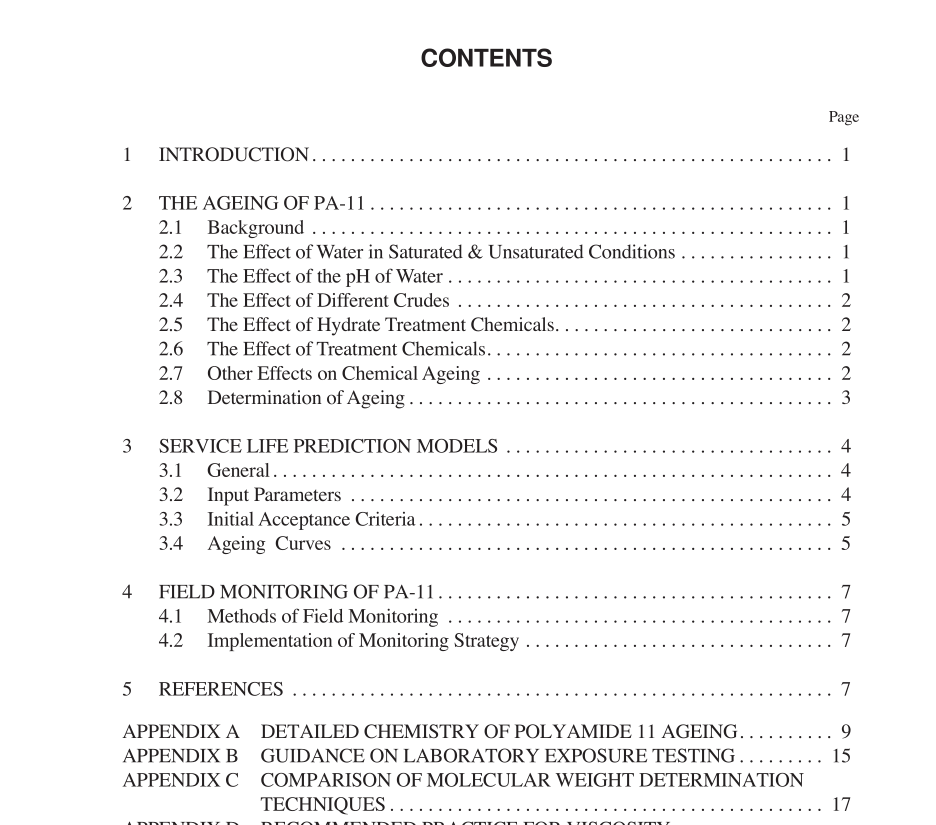API TR 17TR2 pdf download

API TR 17TR2 pdf download.The Ageing of PA-11 in Flexible Pipes
2 The Ageing of PA-11
2.1 BACKGROUND
The main ageing concern regarding PA-11 in ßexible pipe applications, in the absence of oxygen in the bore ßuids, is the effect of water at elevated temperature. The hydrolysis reaction breaks the polyamide links within the polymer, and leads to embrittlement of the material. There is a long history of detailed study of this process, and key references are listed in Appendix A. Pipe manufacturers all use slightly different grades of Ril- san TM PA-11. These differences mainly concern the product speciÞcations and processing parameters deÞned by each manufacturer. It should be noted, however, that two antioxi- dant packages have been used within Rilsan TM PA-11 over the years, both having been fully qualiÞed according to API SpeciÞcation 17J requirements. All data included in this doc- ument is based on experience with PA-11 with the old antiox- idant package. The industry expects that the working life of the PA-11 with the new antioxidant package is expected to be at least comparable to that with the old package, as the basic polymer remains unchanged. The ageing and deÞnition of appropriate acceptance criteria for the PA-11 with the new antioxidant are currently subject to further investigation and quantiÞcation to assure at least equivalent ageing perfor- mance. Therefore it is assumed that the same service life pre- diction method can be used for all PA-11 pipe. The rate of the PA-11 ageing reaction is highly dependent on a number of operational factors including the water con- tent of the ßuid, temperature, acidity (due to carbon dioxide, hydrogen sulphide, organic acids, inorganic acids), oil com- position, and presence of oilÞeld treatment chemicals, such as methanol. Considerations regarding the chemical ageing of PA-11 are detailed in Appendix A, and summarised in the sections which follow. Outline guidelines for conducting lab- oratory ageing experiments are given in Appendix B. It should be noted that other aspects of performance, unrelated to chemical ageing, may inßuence the use of any polymeric material in a ßexible pipe, e.g., mechanical prop- erties, fracture toughness, creep, blistering performance, coefÞcient of friction, thermal expansion, dynamic proper- ties, etc. These other aspects of performance are outside the scope of this document.
2.2 THE EFFECT OF WATER IN SATURATED & UNSATURATED CONDITIONS
Experimental results derived through JIP projects and in- house research along with fundamental chemistry consider- ations conÞrm that the process affecting the ageing of PA-11 in a water environment is reduction in the molecular weight due to hydrolysis. This process is independent of the sheath thickness in typical pipe designs. There is now good agree- ment on this aspect of ageing from different sources. The chemical mechanisms are discussed in Appendix A. If there is free water in a production stream, the PA-11 will age as if immersed in 100% water. It has also been found that a free water phase is not necessary for such ageing to occur. Conditions should be regarded as ÒwetÓ for the consideration of PA-11 ageing if water levels are > 80% of saturation in any given liquid or gas environment ßowing within the pipe (3) .
2.3 THE EFFECT OF THE pH OF WATER
The ageing of PA-11 is accelerated in the presence of acid, under typical Þeld operating conditions. Again, the chemical mechanisms are discussed in detail in Appendix A. The effect of carbon dioxide is to lower the pH of produced water, and so this must be taken into account in PA-11 ageing. The effect of H 2 S on pH can be similarly accounted for. pH can be both calculated and measured. There are several reliable industry and proprietary programs for calculation of pH, based on partial pressures (fugacity), temperature and water chemis- try. Direct pH measurement can be very complicated. To reßect in-situ operating conditions it must be carried out under pressure in order to account for the effect of the acid gases. Consideration of using either the partial pressure (and/or fugacity) of acid gases or pH of the water phase in determin- ing the effect of acid gases on PA-11 ageing is currently under further investigation. Within this document, pH calcu- lated using full water analysis is employed. There may also be a contribution to the pH of the water phase from acids in the oil phase, although there may also be other effects of such acids, as described in the following section.









